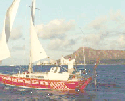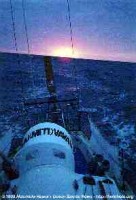Update: Sept 99
BJ Caldwell writes...

 "GLOBAL RACING ON THE RISE"
"GLOBAL RACING ON THE RISE"
"Perhaps because it's affected less by 150 years of conservative yachting tradition, ocean racing is evolving faster than most other branches of competitive sailing. True, the America's Cup has, for the last two cycles, been contested in reasonably modern yachts, and ultra-high-performance skiff racing is about to make its Olympic debut in the guise of the one design 49er class. On the other hand, when it comes to media exposure and broad public interest, the high-profile global races have been running roughshod over pretty much everything that inshore sailing can offer up. Indeed, the next few years will probably bring a changing of the guard, with the America's Cup slipping out of the top spot in the pecking order of international sailing events. Its replacement will almost certainly be an around-the-world ocean race, and likely contenders for the number-one spot (in terms of sponsorship dollars, media attention, and overall public following) are the nine-leg Volvo Ocean Race(formerly the Whitbread), the solo, non-stop Vendee Globe, and a new event of grandiose scope that's known simply as The Race.
For ocean voyaging sailors, whether directly involved in racing or not, there are enormous positive spin-offs from the increasing stature of long-range ocean racing. Everything from weather routing to sail-handling gear is improving by leaps and bounds, thanks in large part to the increasingly rigorous demands of ocean racing. At the same time, a new breed of voyaging yachts with low displacement-to-length ratios, easy-to-handle rigs, and, in some cases, moveable ballast has emerged as a direct result of open class racing developments. And, over a longer time frame, there's a good chance that catamarans will gradually take over from ballasted monohulls as the bread-and-butter choice for serious voyaging.
Now that pro sailors and event organizers are developing a taste for mass media attention and big money sponsorship, the possibility of future "stunt sailing extravaganzas" cannot be entirely dismissed...
LOOKING AHEAD TO THE VENDEE
The next Vendee Globe non-stop solo race is scheduled to start November 5th, 2000. A full field of 20 entries is expected, all in up-to-date open 60s. According to Phillipe Jeantot, winner of two BOCs and chief organizer for the Vendee, the safety and qualification requirements for the millennium race will be far more stringent than in previous editions.
THE RACE: testing the limits
The Race is the dream of Bruno Peyron - best known as the first winner of the Jules Verne trophy for his 79-day circumnavigation aboard the catamaran 'Commodore Explorer'. Fittingly, perhaps, a major sponsor of The Race is Disneyland - a name long associated with flights of fancy. Certainly, it would be almost impossible to conceive of a more freewheeling challenge than a non-stop circumnavigation with no outside assistance aboard crewed sailboats of any size or type.
Naval architects are delighting in the possibilities, and several dominant themes have emerged. A handful favor ballasted monohulls, comparable to open class yachts but expanded into the 50-meter range where in theory their speed potential should match that of 30-to 40-meter multi-hulls. The perceived advantages of an outsized monohull are straightforward structural engineering and the self-righting potential that allows a crew to push harder without risking ultimate catastrophe.
To date, all three successful Jules Verne challengers (circumnavigations in less than 80 days) have been made in multihulls, and most teams aiming for The Race are planning either an enormous catamaran or trimaran. Despite the fact that the current record is held by a tri, the cat configuration is generally favored because it appears to be a little more predictable and a little less expensive. However, a 32-meter foil-stabilized trimaran designed by Guy Lombard for Loick Peyron has the earmarks of success, in large part thanks to a brilliant skipper who has dominated the 60-foot trimaran scene for the past four years."
- Sven Donaldson
Ocean Navigator Sept/Oct 1999
Brad Cole and bj wrote:
Earl Edwards' "RAVE"
One day I was at a canoe club in Nawiliwili, on the island of Kaua`i, the smallest and most exposed of the larger Hawaiian Islands. During a break between races I wandered down to the end of the road where I happened upon what was at the time the largest sailing multihull in the world under construction at the water's edge. As I walked around these three huge hulls I encountered Earl Edwards and he told me some of the story of this epic project that has consumed a dozen years of his life.
Earl grew up between Los Angelos, Seattle and Hawai`i; it was on Waikiki Beach in the mid-50's that he first experienced multihull sailing on catamarans there. Influenced by Duke Kahanamoku and Rudy Choy, he enjoyed the speed and thrills of heavy air, light displacement sailing. Back in 1982 Earl conceived the idea of building a huge trimaran sloop to cap off his career in boat building and retire to sailing around the world. His experience as an aeronautical engineer and yacht designer, builder, and racer inclined him towards a multihull and, with input from Randy Smyth on the basic concept and the sail plan, came up with a picklefork trimaran. It's called a picklefork because the amas are in advance of the main hull, the purpose of which is greater stability in a seaway. The amas are designed as wave piercers, the main hull is a skimmer type with a lot of rocker to reduce wetted surface in light airs. It has a central daggerboard to eliminate ventilation and a deep knuckle to extend the butt lines. The overall concept is to be large, light, fast and stable with a sufficient stiffness and flexibility to go anywhere.
His vision led him to an empty lot up the Niumalu river in Nawiliwili. There he started the lofting and lay-up of his ship with the aid of his two assistants, Jody Gardner and Sandra Marcy. I say ship because it's of impressive dimensions. The overall length of 118', beam of 78', and displacement of 20.5 tons. Each ama is 102' and the center hull is 103'. The hull draws 2.5', the draft with daggerboard down is 19.5', and the mast height above water is 162'. The laminate was designed for both strength and flexibility, vinylester resin being used with mainly S-glass and local carbon reinforcement. Unbaked and unbagged, each layer was meticulously applied by Edwards and his skilled crew for a remarkably clean laminate using male molds.
The hulls were just begun when disaster struck in the form of one of the periodic hurricanes that come to Kaua`i. After the 12 hours of Iniki's fury, the molds were miraculously intact with some minor damage. But all of the materials for the hulls, spars and iakos were blown away along with most of the equipment and tooling mobilized on the site. It was some month before Earl and his partners regrouped and got back to the task at hand. It would take them another seven years to finish the hulls and their interior, the iakos, and put the pieces together to float the boat for rigging and finishing. The completion of this vessel is solely due to the indefatigable persistence of Earl and Jody. They have persevered at their task for years on an open site exposed to the strong winds, sun and rain of Kaua`i. They fabricated their tooling as required, made do with what equipment they could get locally and created a high tech racing boat.
During the interim, interest in multihull racing and the concept of open class racing has grown. Frenchman Bruno Peyron (the first to win the Jules Verne Trophy for a circumnavigation in under 80 days aboard his 86' catamaran "Explorer") has organized "The Race", a no-limits nonstop circumnavigation race for yachts of any size. In the process, the rest of the world has caught up and now what was the largest multihull sailing yacht ever built has become one of a pack striving to complete in time to race against the likes of Steve Fossett's Playstation. And what was once a relatively incurious local population is now out in the open. Today Rave is on the verge of launching with the hull to be completed bonded together in the next thirty days. At which time she will be launched for final fitting out, rig fabrication and installation.
How does Rave compare to Playstation? She is 14' longer, 21' wider, 5.5' deeper, and her wing mast will be 24' higher above the water with an estimated increase in displacement of one ton. Her total area in nearly 3000 square feet greater. This is some platform and obviously capable of great power and speed. If the design is as stable as the numbers imply, 600 mile days are well within her capacity. As a trimaran in a field of catamarans, she enjoys the obvious advantages of more power in heavy air and less wetted surface in light air. Another advantage is that with her completion so close she will have ample opportunity to tune up before "The Race".
What will be this project's outcome? Earl is determined to finish in time to qualify for "The Race". Beyond that he would like to set round-the-world and trans-ocean records, perhaps a course originating in Hawai`i, his adopted home. But at this time he is still seeking commercial partners to underwrite the finishing of this mighty vessel and the ensuing record attempts. It is truly an amazing tale of perseverance and vision worthy of an equally epic outcome.
- Brad Cole and bj
...as for bj, it has been a wonderful summer with the sea. It began when I delivered the Passport 40 "Mandorla" to San Francisco from Honolulu. Next I delivered the Alan Andrews 70+ "Magnitude" (2nd place overall in the 1999 TransPac Race) to Los Angelos. I followed that up by double-handing the Farr 40 "Orient Express" to San Francisco from Los Angelos. In the mean time, I trained with Byron Watson aboard his F-31 trimaran "Bethany". Next it was back to Honolulu from LA aboard the 82ft maxi "Sorcery" in 9 days...
- right now i am preparing for a delivery in just a few days to the western Pacific islands aboard a 28ft Hawk-farm. Then its off to Fiji probably, to bring a 30fter up to Honolulu...
"Rave" should keep me pretty busy on land, imagine the design...A 118'ft picklefork trimaran. Whether we decide to do The Race, assault the Jules Verne Trophy or just disappear cruising forever, "Rave" will bring us closer to the sea...STAY TUNED.
bj caldwell

 HoloHolo Hawai`i Ocean Sports News
HoloHolo Hawai`i Ocean Sports News